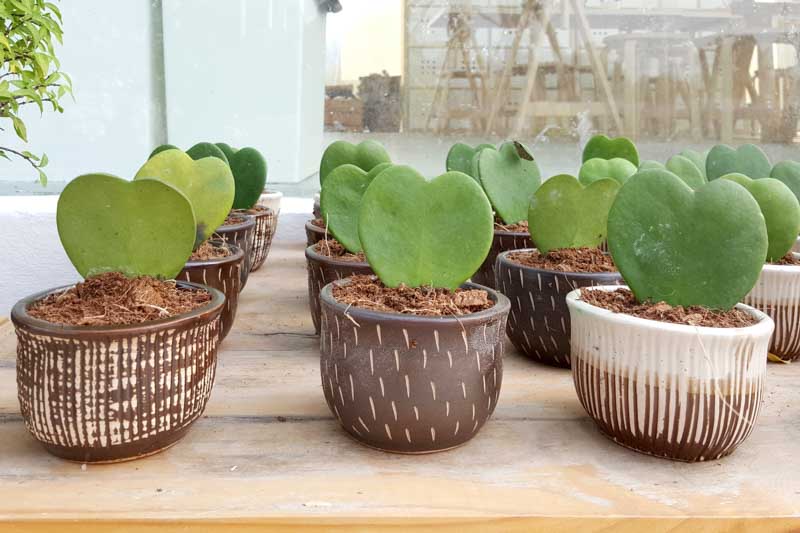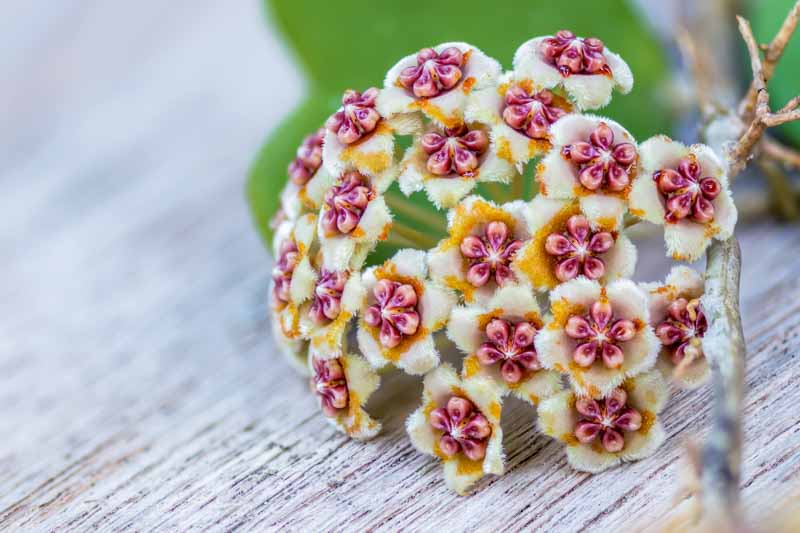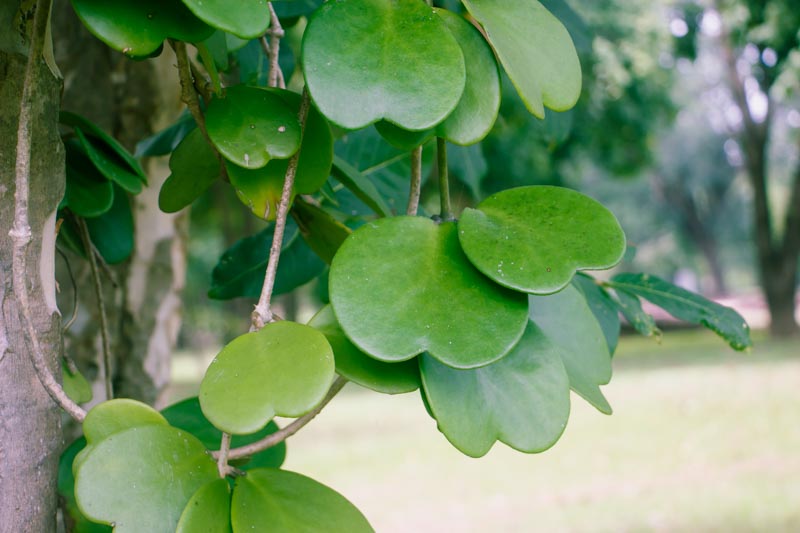Lucky Heart Plant, Sweetheart Hoya, Sweetheart Plant, Sweetheart Valentine Hoya, Valentine Hoya, Wax Hearts
Hoya kerrii, affectionately known as the Sweetheart Hoya or Valentine Hoya, features distinct heart-shaped leaves, making it a favorite among plant lovers, especially as gifts on romantic occasions.
Hoya kerrii is a delightful, heartwarming plant that is relatively easy to grow with the right conditions. It has a vining growth habit, which allows it to climb structures or trail from hanging pots. It’s especially popular for its striking heart-shaped leaves and, on mature plants, its beautiful and fragrant flowers.
Native: This species is native to Southeast Asia, where it can be found growing naturally in countries like Thailand, Vietnam, and Laos, usually on tree trunks in rainforest settings. It belongs to the dogbane family (Apocynaceae), along with plumeria, periwinkle, mandevilla, or oleander.
Plant Type and Habit: Hoya kerrii is a slow-growing evergreen vine. In its natural habitat, it uses aerial roots to climb trees. As a houseplant, it is often grown in hanging baskets or on supports to encourage its climbing habit.
Size: When grown indoors, Hoya kerrii can reach several feet in length, though its growth rate is slow, and the single leaf ‘Sweetheart’ variety often sold for Valentine’s Day typically remains a solitary leaf unless properly propagated. In its native environment, it can grow 13 feet tall (4 meters)
Hoya Flower: Sweetheart Hoya produces clusters of small, star-shaped flowers that are white or pale pink with a central red or burgundy corona. The flowers are fragrant and produce nectar, making them quite sticky. Flowering generally occurs in the warmer months, but only on mature plants (2 or 3 years old). Younger plants or single leaf cuttings often do not bloom.
Fruit: Fruiting is rare, especially in cultivated plants, but in their native environment, they can produce seed pods after successful pollination.
Foliage: The heart-shaped, fleshy, bright green leaves are the most notable feature. They can grow quite large, typically reaching 2 to 5 inches (5 to 12 cm) in length when grown as houseplants. In some cases, particularly when the plant is allowed to climb in ideal growing conditions, the leaves can become even larger, surpassing 6 inches (15 cm) in length.
Hardiness: It is hardy in USDA zones 11-12 if planted outdoors; however, it is mostly grown as an indoor plant due to its need for a consistently warm environment.
Uses: Hoya kerrii is primarily used for ornamental purposes. Its unique foliage and potential for flowers make it popular in homes, offices, and as gifts, especially around Valentine’s Day. A mature, well-cared-for Hoya kerrii can live for many years, becoming a treasured part of your plant collection.
Toxicity: Hoya kerrii is non-toxic to pets and humans, making it a safe choice for a household plant.
Invasiveness: It is not considered invasive, as it’s mostly grown in controlled indoor or greenhouse environments.
Benefits: Like other Hoya plants, Hoya kerrii is believed to help purify indoor air, although this benefit is not as significant as other well-known air-purifying plants.

Growing and caring for Hoya kerrii is relatively straightforward, making it a perfect choice for both novice and experienced gardeners.
Light: Hoya kerrii prefers bright, indirect sunlight. Too much direct sun can scorch the leaves, while too little light can inhibit growth. A spot near an east or west-facing window is ideal.
Soil: Use a well-draining potting mix. A mix designed for succulents or cacti is suitable, or you can make your own by blending regular potting soil with perlite, sand, or orchid bark to increase drainage.
Water: Water when the top inch of soil feels dry to the touch, typically every 1-2 weeks, depending on the humidity and temperature of your home. Overwatering can lead to root rot, so ensure proper drainage. Reduce watering in the winter months.
Temperature and Humidity: Ideal temperatures range from 60°F to 85°F (15°C to 29°C). Avoid sudden temperature drops and drafts, as they can stress the plant. While Hoya kerrii can tolerate average household humidity levels, it thrives in higher humidity. Consider placing it on a pebble tray with water or using a humidifier if your home is particularly dry.
Fertilization: Feed your Hoya kerrii with a balanced, water-soluble fertilizer diluted to half strength once a month during the growing season (spring and summer). Do not fertilize in the winter.
Pruning: Pruning is not necessary for the health of your Hoya kerrii, but you can trim it to maintain shape or remove any unhealthy leaves. Use clean, sharp scissors or pruning shears to avoid damaging the plant.
Flowering: Hoya kerrii flowers are less common but possible under optimal conditions. To encourage blooming, provide bright, indirect light and consider using a phosphorus-rich fertilizer during the growing season.
Repotting: Repot Hoya kerrii every 2-3 years in spring, using a well-draining potting mix and a pot just slightly larger than the current one. Ensure the pot has drainage holes to prevent waterlogged soil, which can lead to root rot.

Propagating Hoya kerrii can be done using leaf cuttings or stem cuttings. Here’s how to do it:
After propagation, care for your new Hoya kerrii plant as you would a mature one. Place it in bright, indirect light, water it when the top inch of soil feels dry, and provide it with high humidity if possible. With patience and proper care, your propagated Hoya kerrii will grow into a beautiful, heart-leaved plant.

Hoya kerrii is generally resilient, but like all plants, it may encounter pests and diseases.
Mealybugs: Look for white, cottony masses on stems and undersides of leaves. Remove with alcohol-dipped cotton swabs or apply insecticidal soap.
Scale insects: Hard, dome-shaped pests that attach firmly to stems and leaves, feeding on sap. Their presence can lead to yellowing leaves, stunted growth, and a decline in plant health.
Aphids: These small, sap-sucking pests can infest Hoya kerrii, clustering on new growth and undersides of leaves, causing wilting and distortion. Treat with neem oil or insecticidal soap.
Spider mites: Cause yellowing leaves and fine webs. Increase humidity and treat with miticide or insecticidal soap.
Root rot: Caused by overwatering and poor drainage. Ensure well-draining soil and allow the topsoil to dry out between waterings.
Leaf Yellowing: Overwatering or poor drainage can lead to yellow leaves. Adjust your watering schedule and ensure the pot allows for drainage.
Lack of Flowering: Hoya kerrii needs bright, indirect light to bloom. If it’s not flowering, it might need more light.
Slow Growth: Can be due to low light levels or the need for fertilization. Provide bright, indirect light and feed with a balanced, water-soluble fertilizer during the growing season.
Drooping Leaves: Often a sign of underwatering or too much direct sunlight. Check the soil moisture and move the plant to a place with bright, indirect light.
Yes, Hoya kerrii can technically grow roots from a single leaf cutting, but it’s a slow process, and the leaf alone often does not develop into a full plant with vines. For more successful propagation, a stem cutting with at least one node is recommended, as it’s more likely to produce both roots and new growth.
Hoya kerrii, especially the single-leaf potted versions, is commonly available in many nurseries and plant shops. However, larger, mature plants or specific varieties such as variegated forms can be less common and considered more of a collector’s item among houseplant enthusiasts.
Yes, Hoya kerrii is known to be a slow grower, especially when grown from a single leaf. When provided with optimal growing conditions (bright, indirect light and sufficient humidity), they can exhibit more vigorous growth, particularly when they are well-established and root-bound.
Hoya kerrii can grow quite large over time, with vines reaching 13 feet in length (4 meters) under the right conditions. Its growth habit is trailing or climbing, and with adequate support, it can be encouraged to grow quite long, though this takes time due to its slow growth rate.
Hoyas, including Hoya kerrii, are versatile and can thrive either as climbing plants with support or as hanging plants where their vines can drape beautifully. The preference depends on how you wish to display the plant and the space available.
Like many Hoyas, Hoya kerrii often thrives when slightly root-bound. This condition can encourage flowering and make the plant more manageable in terms of size. However, it’s important not to let it become excessively root-bound, as this can hinder its growth and health. Repotting every few years into a slightly larger pot is generally sufficient.
| Hardiness |
11 - 12 |
|---|---|
| Plant Type | Houseplants, Climbers |
| Plant Family | Apocynaceae |
| Genus | Hoya |
| Exposure | Partial Sun |
| Season of Interest |
Spring (Early, Mid, Late) Summer (Early, Mid, Late) Fall Winter |
| Height |
1' - 13' (30cm - 4m) |
| Maintenance | Low |
| Water Needs | Average |
| Soil Type | Loam, Sand |
| Soil pH | Acid, Alkaline, Neutral |
| Soil Drainage | Well-Drained |
| Characteristics | Showy, Evergreen, Fragrant |
| Garden Uses | Beds And Borders, Hanging Baskets, Patio And Containers |
| Garden Styles | Mediterranean Garden |
| Hardiness |
11 - 12 |
|---|---|
| Plant Type | Houseplants, Climbers |
| Plant Family | Apocynaceae |
| Genus | Hoya |
| Exposure | Partial Sun |
| Season of Interest |
Spring (Early, Mid, Late) Summer (Early, Mid, Late) Fall Winter |
| Height |
1' - 13' (30cm - 4m) |
| Maintenance | Low |
| Water Needs | Average |
| Soil Type | Loam, Sand |
| Soil pH | Acid, Alkaline, Neutral |
| Soil Drainage | Well-Drained |
| Characteristics | Showy, Evergreen, Fragrant |
| Garden Uses | Beds And Borders, Hanging Baskets, Patio And Containers |
| Garden Styles | Mediterranean Garden |
How many Hoya kerrii (Sweetheart Plant) do I need for my garden?
| Plant | Quantity | |
|---|---|---|
| Hoya kerrii (Sweetheart Plant) | N/A | Buy Plants |
Create a membership account to save your garden designs and to view them on any device.
Becoming a contributing member of Gardenia is easy and can be done in just a few minutes. If you provide us with your name, email address and the payment of a modest $25 annual membership fee, you will become a full member, enabling you to design and save up to 25 of your garden design ideas.
Join now and start creating your dream garden!
Create a membership account to save your garden designs and to view them on any device.
Becoming a contributing member of Gardenia is easy and can be done in just a few minutes. If you provide us with your name, email address and the payment of a modest $25 annual membership fee, you will become a full member, enabling you to design and save up to 25 of your garden design ideas.
Join now and start creating your dream garden!